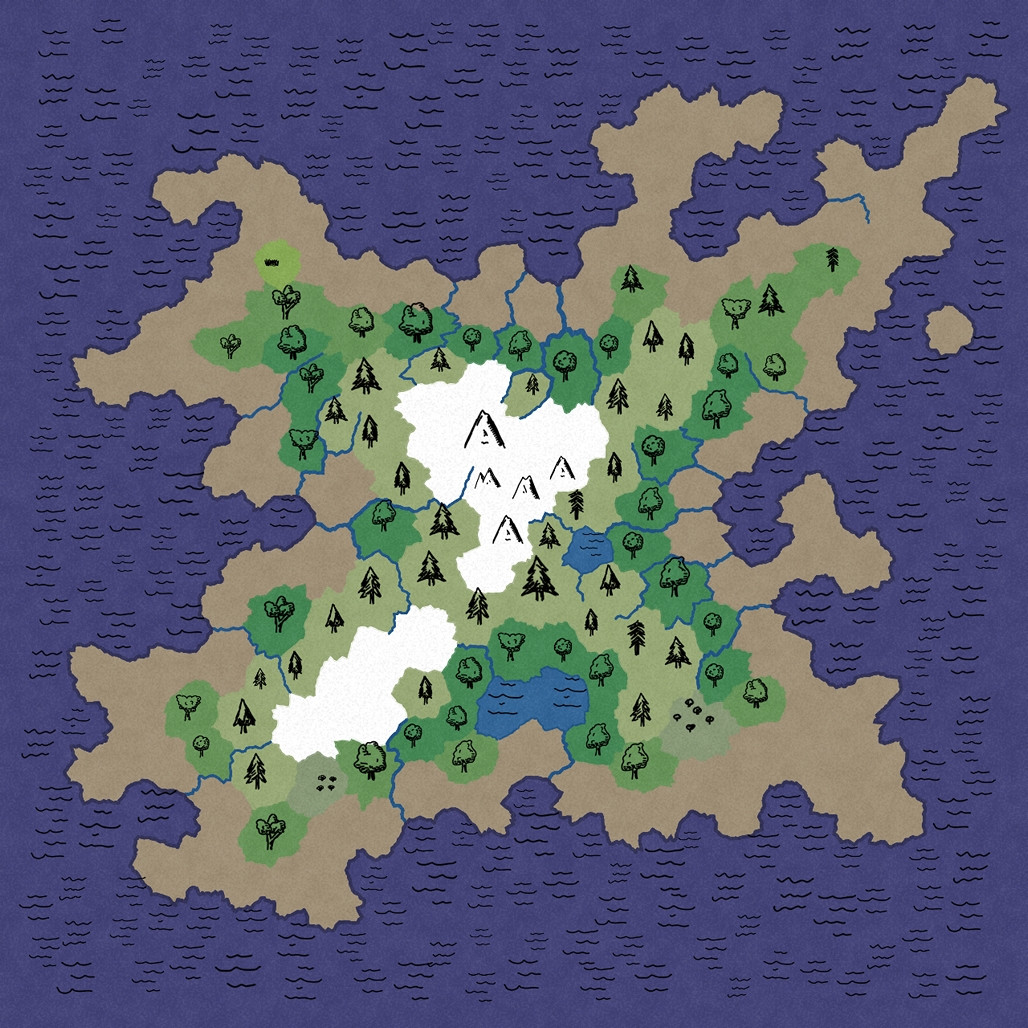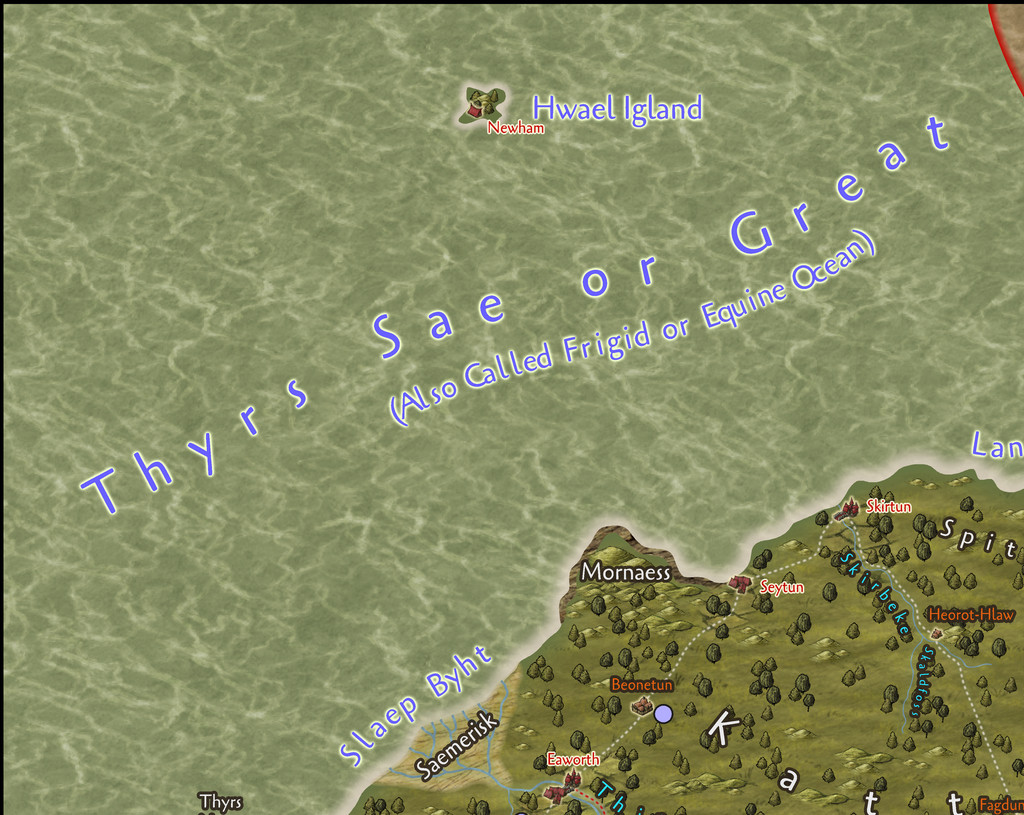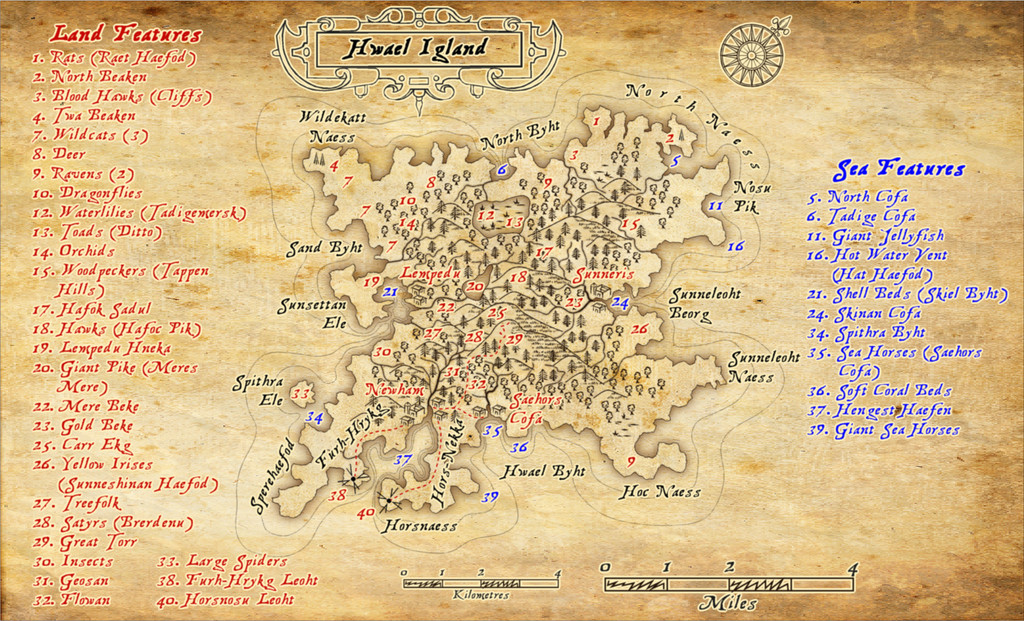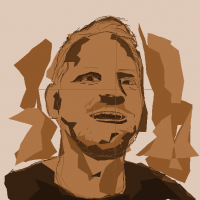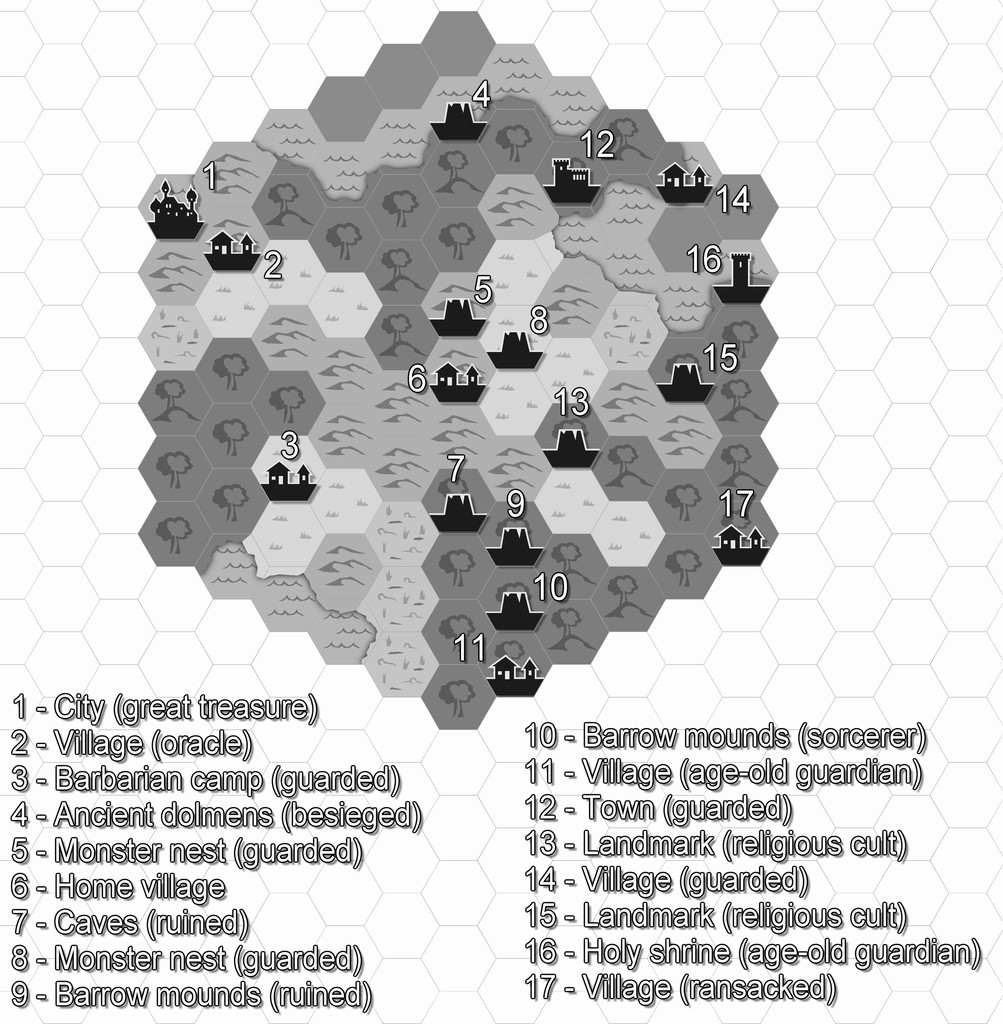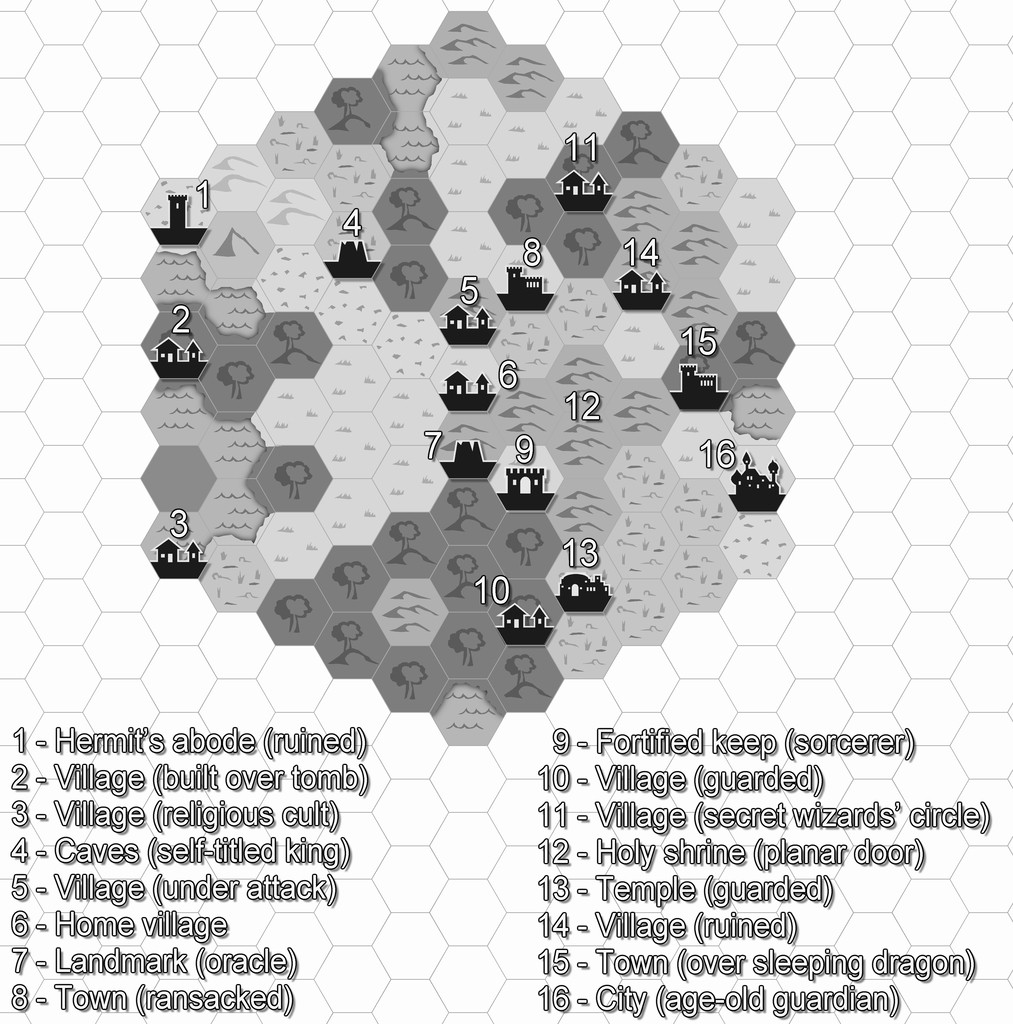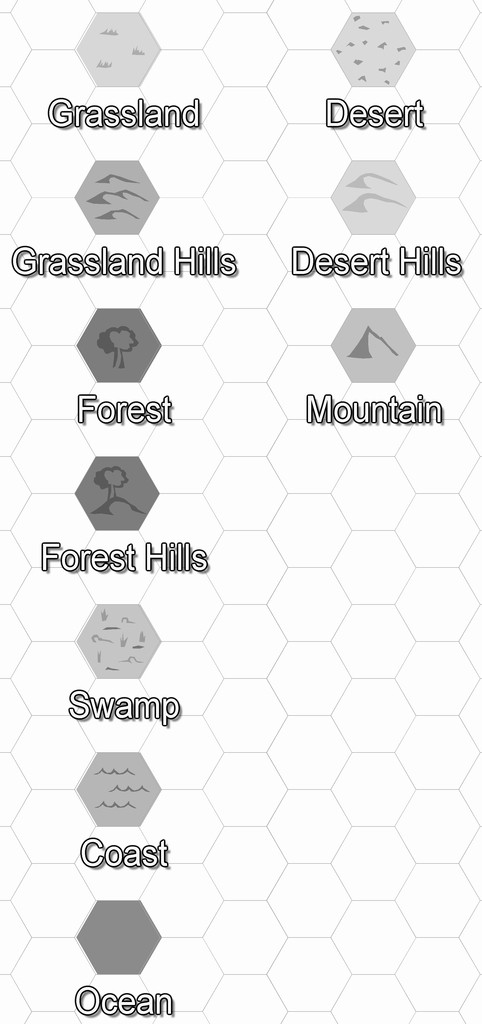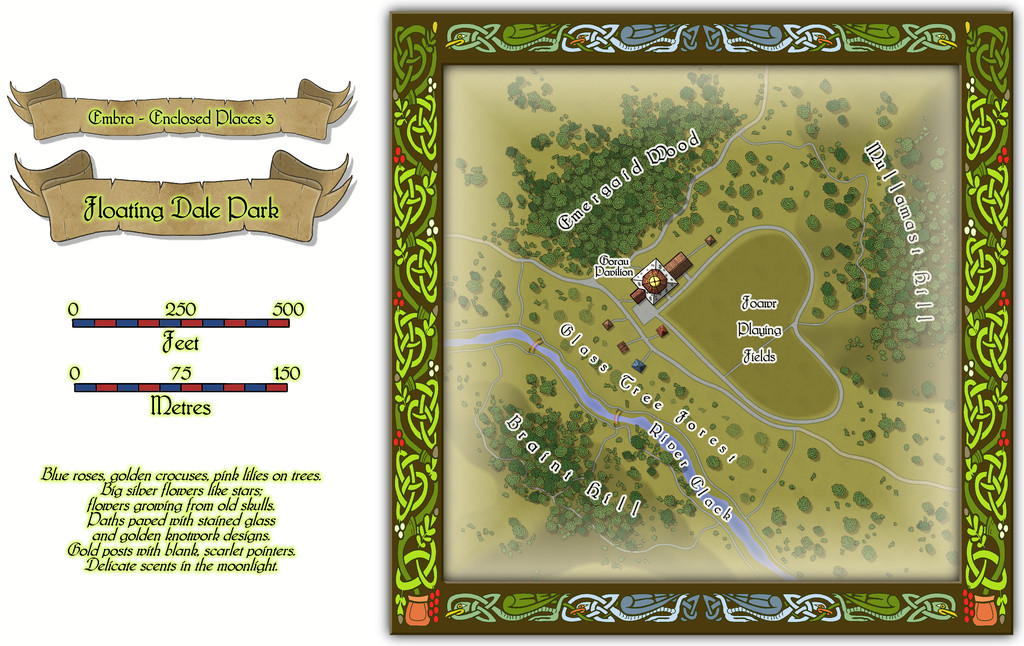
Wyvern
Wyvern
About
- Username
- Wyvern
- Joined
- Visits
- 3,153
- Last Active
- Roles
- Member
- Points
- 5,382
- Rank
- Cartographer
- Badges
- 24
-
Community Atlas: Errynor Map 33 - Hwael Igland
Well, it's already in the Atlas, but these notes maybe add something regarding the creation process, and some of the problems encountered in preparing it. So, as mentioned in the Siolforland map Forum topic, I wanted to add an additional map to that main one, for the little offshore isle of Hwael Igland, although this is actually the largest of my planned islands off Errynor. During the original planning for this whole Errynor mapping project some years ago, I'd brought together a number of randomly-generated ideas, including a series of base-maps for the scatter of tiny islands in Errynor's seas from the island generator on the Red Blob Games website. The base chosen here was:
This is only one of the map views the site generates, showing just the chief biomes, with symbols and colour-coding. Other views provide more detail on the physical terrain. The rough-edged, sort-of hexagonal pattern the random system uses to create the map is naturally quite obvious here, although personally, this is quite appealing anyway, and produces some interesting coastal shapes especially. The random maps have no scale illustrated, so adjusting them to whatever size is needed is very straightforward, and here largely revolved around calling the mountains "hills", and the rivers "streams".
When generating the random island base maps, I had the overall shape for each in mind from my original hand-sketched Errynor maps, and simply tried different random options until I arrived at a suitably-shaped island for each. In this case, I'd decided this shape fitted what I'd already sketched, but only once it was inverted, as suggested by the final Siolforland drawing, even if the similarity is a bit vague:
Of course, the random base map is very incomplete, given the final Island needed at least one settlement on it, and for an Atlas map, it also needed further points of interest adding. So a series of fresh random rolls on my small-scale-map-feature tables were made, after which a fresh evaluation of the landscape was carried out, and some adjustments made, including factoring-in considerations from the Siolforland mapping (such as the already-decided height of the highest peak on the Island). Then the CC3+ mapping could begin.
As normal, I'd identified several possible mapping styles to use. Here, I was picking from some of the simpler black-and-white styles, suitable for the relatively small area involved. Partly this was a reaction against having been mapping purely in colour for some considerable time up to this point (not simply with my Errynor mapping), and partly a reaction to having mapped two Errynor islands previously in colour, Zariq and Zaraq on Errynor Map 01. However, the style I eventually settled upon, "Treasure Maps" from CA58 in 2011, was one I have used before in Errynor, when mapping the seafloor surroundings of the Kachayan settlements at Shark Bridge in the deep ocean of Map 01. On that occasion though, I'd really used little more than a couple of symbols, the backdrop parchment fill and font from the Annual issue, and had drawn my own not-symbol vector-shape objects for use there instead. This time, I was using the style more as it was meant to be, for a sea-surface island:
Once drawn, as soon as I started adding the labels, it became very obvious space wouldn't allow them all to be fitted on the map, so the background rapidly had to expand to fit the points-of-interest listings, to which I added a further minor complication by using colour-codings for the features on land, and those around the coast and in the sea, while retaining just the one numerical sequence! And then in the PDF description, I added-in the named places, breaking-up that sequence still further, which was an interesting experiment in producing a non-alphanumeric index...
Part of the reason I'd chosen this mapping style was because it allows the drawing of cliffs, as well as providing other landform symbols. The perceptive will, however, notice there aren't any cliffs drawn on the final map. Unfortunately, I soon discovered that at this map's size, the cliffs looked unworkably clumsy, as the drawing tool for them uses a non-scalable hatch fill, and moreover it sometimes reacts very badly to drawn polygons containing strong convex and concave curves (such as when trying to illustrate that cliffs continue right around a narrow peninsula, or a coastline with substantial indentations). In such cases, it can force part of the hatch fill beyond the drawn borders, so that the land looks like it's ALL cliffs in places, not just at the coasts. Even drawing the cliffs in small segments didn't work, because sometimes there was scarcely anything visible to show there were meant to be cliffs within the polygon area, and others where the polygon was almost all solid black fill. So I settled for relying on just descriptions in the PDF for where the cliffs lie (there are meant to be at least low cliffs around most of the Island's shores, and a couple of places where they're inland too).
There's a similar issue with the hatch fills for the marshes and the "grassy-look" texture on the hills, though luckily the hill symbols don't rely on that hatch fill, as they're scalable objects in their own right, as normal, while there's a series of individual marshland symbols in the Annual as well (which I was particularly relieved to find after trying the marsh drawing tool, with similar problems to the cliffs). I toyed briefly with drawing suitable shapes into separate polygons for the cliffs I wanted, only to veto that as far too time-consuming in this case. I assume part of this problem stems from the fact the style's intended to be used for maps around 20-25 miles or so across (as the PDF mapping guide suggests), whereas Hwael Igland fits very easily within a 10-mile square.
Despite this, I was pleased with how the final map had worked out, and to have had the chance to play around with a style I'd barely touched previously.
-
The Creepy Crypt project
-
Panzer sample thread
So far as I recall from modelling the 8- and 6-rad armoured cars (i.e. also from period images and information), the aerials were fixed in position, and at a height above the turrets all the time. These are the early-war "bedstead" frame aerial types, not the later war smaller "star antennae" which were retrofitted to some models, incidentally.
Oh - and belated congratulations on your ascension to Master Mapper status @Lillhans ! Very well done!
-
Hexcrawling starter maps
The published maps and artwork for ShadowDark all tends to be black-and-white. I don't mean greyscale here, but sharply-contrasting black-and-white line hand-drawings. It would be good to have something similar for CC3+ (especially for dungeon-style maps, as the current CC black-and-white dungeon styles don't have sufficient bitmap options, or high enough symbol and bitmap resolutions, to look sufficiently clear and presentable - I did some tests for this too), particularly given the current popularity of OSR systems overall, which tend to favour this kind of map look in general. It is though easy enough to convert these maps to at least greyscale, simply by adding a suitable RGB Matrix Process effect to the whole map:
Oh, and a minor tweak to the colour of the lettering!
-
I Can't Buy Campaign Cartographer And Other Such Products
You should though check your card provider's terms and conditions before carrying out the transaction, as you may find there's a small extra fee to convert the currency (about 3% of the transaction value is common, though not universal). Like Loopysue, I'm in the UK, but have carried out transactions this way for some years for US, Canadian and New Zealand Dollars and Euros, for instance, and the transactions have always been pretty straightforward.
Also, if you're concerned, you can pay through PayPal (even if you don't have a PayPal account), and that shows you exactly how much you'll be paying in your own currency, including the conversion fee (and your card provider shouldn't charge you any extra).
-
Community Atlas: Embra - Enclosed Places
Enclosed Place of Interest 3 is the Floating Dale Park:
This can be used as a typical real-world park, with opportunities to wander around, or play outdoor games on the central Playing Fields, whose unusual shape may call to mind that Faerie outdoor games and sports may not be quite those familiar from the Mortal Realm.
There are a handful of surface-level buildings scattered around the map's centre, as one of the map toggles will reveal:
These include the Pavilion, where equipment for playing sports and games is available, as well as a restaurant in the central octagon beneath the building's dome. And yes, some of the vegetation is actually intended to be of living glass in Glass Tree Forest. And again yes, those ARE bridges made from rainbows over the River Clack. As ever, the text and PDF files will explain a little more about both facets, and others, from this map. In case this seems not very "Enclosed", there ARE boundaries to the Park which are deliberately less obvious than some.
-
WIP - Wayward Village and Inn
Glitch commented: 2. Use the select point option to draw grid box. Easy to do, but if you have and irregular building, setting two grid boxes creates a misalignment of the two grids.
It shouldn't create a misalignment if you use the snap grid properly, but you may need to mask the second grid in places. Or you could just draw one grid across all, and mask those areas of the grid that lie beyond the structure's walls.
As with most things in CC3+, there isn't just one option for solving issues like this - it's which one you're more comfortable with that typically wins the day.
-
Live Mapping: Character Artist 3
Just finished catching-up with today's video, as I wasn't able to be there for it live.
I've used Character Artist quite a bit over the years, and it was a shame to discover there are no plans to update or expand it, if perhaps understandably so, given it is something of a "luxury" add-on, compared with the primary mapping purpose of CC3+ in general.
Reviewing the video so soon after it was posted means the chat wasn't available to view (it sometimes is lost anyway, if the video is later edited before its final YouTube posting), but I don't think it was mentioned there that there is also the original Character Artist Pro, which has many more drawn-symbol options than CA3, and is much easier to draw your own additions onto, because it uses the far simpler vector drawing style. I suspect many now wouldn't feel it to be "pretty" enough, compared to the more modern hand-drawn version, unfortunately, but it is a versatile tool that shouldn't be ignored - to me, at least!
-
Dungeon Level Symbols
-
Community Atlas: Embra - Hilly Places
Thanks very much Sue!
I wanted the cliffs here to look different to yours, which I'd already decided to use for the red sandstone types at Embra, as the Palace Heights ones are meant to be a harder, volcanic type of rock. Actually, a Faerie type of volcanic rock, which has different properties and abilities to "ordinary" volcanic rock, so I also wanted the forms here to act as a reminder that something a little different to normal was involved. I also used a similar style of cliff drawing in one of the Crossing Places Streets - the Rocky Vale under Seafield Road there, again because the Vale is a weird place that can't be reached, another reminder of something odd happening there.



